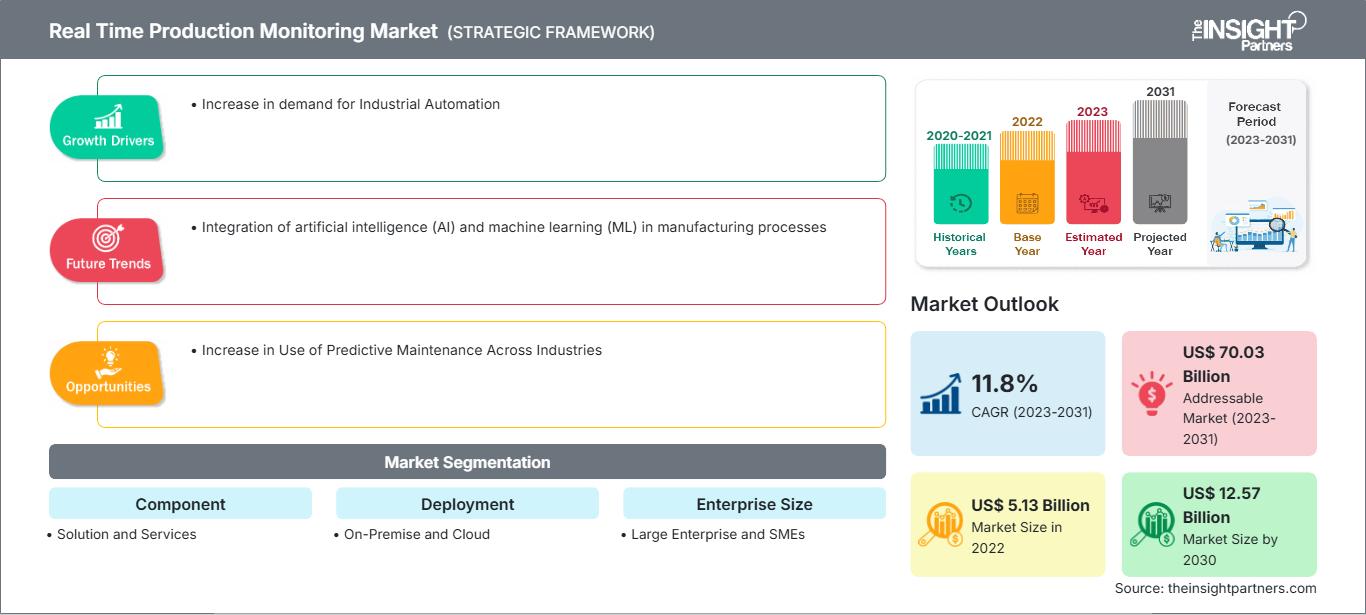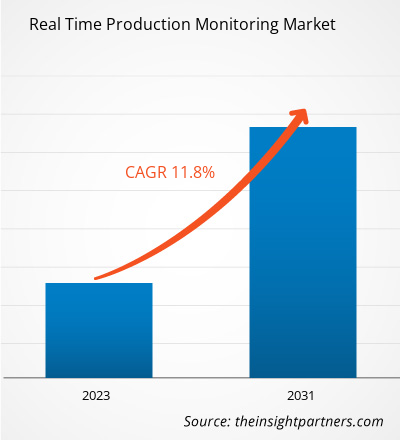实时生产监控市场规模预计将从 2022 年的 51.3 亿美元增至 2030 年的 125.7 亿美元。预计该市场在 2022 年至 2030 年期间的复合年增长率为 11.8%。人工智能 (AI) 和机器学习 (ML) 在制造过程中的融合可能仍将是市场的一个关键趋势。
实时生产监控市场分析
由于对数字化制造的需求不断增加,市场稳步增长。制造业的数字化促使制造商采用多种技术,因为它有助于有效地管理生产过程。
实时生产监控市场概览
实时生产监控是一种有助于监控生产过程的解决方案。它实时记录与生产性能有关的所有信息。监控系统从多个生产线源收集生产数据,供制造商或生产线上的操作员使用。收集到的数据随后被用于洞察高效生产流程所需步骤,从而提高生产线效率。许多制造企业在汽车、化工、石油天然气、机械以及食品饮料等垂直行业的实时生产监控市场中采用了这些解决方案。
自定义此报告以满足您的要求
您将免费获得任何报告的定制,包括本报告的部分内容,或国家级分析、Excel 数据包,以及为初创企业和大学提供超值优惠和折扣
实时生产监控市场: 战略洞察

- 获取本报告的主要市场趋势。这个免费样本将包括数据分析,从市场趋势到估计和预测。
您将免费获得任何报告的定制,包括本报告的部分内容,或国家级分析、Excel 数据包,以及为初创企业和大学提供超值优惠和折扣
实时生产监控市场: 战略洞察

- 获取本报告的主要市场趋势。这个免费样本将包括数据分析,从市场趋势到估计和预测。
实时生产监控市场驱动因素和机遇
工业自动化需求增长利好市场
工业自动化使用控制系统(例如机器人、计算机和信息技术)来处理行业中的各种机械以取代人工干预。根据所涉及的操作,工业自动化控制系统主要分为两类:过程工厂自动化和制造自动化。工业自动化通过部署新的、创新的和集成的技术和服务,提供高产品质量、可靠性和生产率,同时降低生产和设计成本。它们具有高生产率、高质量、灵活性和信息准确性等各种特点,这些特点可能会在预测期内增加工业部门对自动化的采用。此外,石油和天然气、制造、化学品和材料、制药和其他行业正在推动实时生产监控市场的增长。
各行业预测性维护使用率的提高
随着数字技术的进步,许多制造业正在利用预测性维护。这些智能行业使用制造资产的实时数据,并分析工厂车间传感器获取的海量大数据。这种分析需要预测性维护来减少设备停机时间。实时生产监控系统可以跟踪设备并发出警报,以便仅在真正必要时才进行工作。此外,这些系统通常作为模块提供,以补充企业资源计划 (ERP) 系统,提供类似于标准计算机化维护管理系统 (CMMS) 的预防性维护功能。
实时生产监控市场报告细分分析
有助于得出实时生产监控市场分析的关键细分是组件、部署、企业规模和行业。
- 基于组件,市场按解决方案和服务进行细分。解决方案细分市场在 2022 年占据了相当大的市场份额。
- 根据部署情况,市场分为本地部署和云端部署。2022 年,云端细分市场占据了更大的市场份额。
- 根据企业规模,市场分为大型企业和中小企业。2022 年,大型企业细分市场占据了更大的市场份额。
- 根据行业情况,市场分为流程制造和离散制造。2022 年,流程制造细分市场占据了最大的市场份额。
按地区划分的实时生产监控市场份额分析
实时生产监控市场报告的地理范围主要分为五个区域:北美、亚太地区、欧洲、中东和非洲以及南美和中美洲。
预计亚太地区将在 2022 年占据市场主导地位。亚太地区长期以来一直是强大的制造业基地,该行业继续大力采用物联网。物联网在亚太地区的各个垂直行业中得到广泛应用,并推动了数字化解决方案的采用。该地区制造业潜力巨大。2023年3月,罗克韦尔自动化公司发布了第八份年度《智能制造现状报告》。根据一项对澳大利亚、印度、中国、韩国和日本等国家/地区1,350家制造商的调查,亚太地区约44%的制造商计划在未来一年内采用智能制造,而中国约80%的制造商、澳大利亚约60%的制造商和印度约59%的制造商已在使用部分智能制造组件。因此,智能制造的日益普及以及现有的智能制造设施代表着亚太地区强大的实时生产监控市场份额,因为该解决方案有助于智能设施实时高效地管理生产工作流程。
实时生产监控市场区域洞察
The Insight Partners 的分析师已详尽阐述了预测期内影响实时生产监控市场的区域趋势和因素。本节还讨论了北美、欧洲、亚太地区、中东和非洲以及南美和中美洲的实时生产监控市场细分和地域分布。
实时生产监控市场报告范围
| 报告属性 | 细节 |
|---|---|
| 市场规模 2022 | US$ 5.13 Billion |
| 市场规模 2030 | US$ 12.57 Billion |
| 全球复合年增长率 (2023 - 2031) | 11.8% |
| 历史数据 | 2020-2021 |
| 预测期 | 2023-2031 |
| 涵盖的领域 |
By 组件
|
| 覆盖地区和国家 | 北美
|
| 市场领导者和主要公司简介 |
|
实时生产监控市场参与者密度:了解其对业务动态的影响
实时生产监控市场正在快速增长,这得益于终端用户需求的不断增长,而这些需求的驱动因素包括消费者偏好的演变、技术进步以及对产品优势的认知度的提升。随着需求的增长,企业正在扩展其产品线,不断创新以满足消费者需求,并抓住新兴趋势,从而进一步推动市场增长。

- 获取 实时生产监控市场 主要参与者概述
实时生产监控市场新闻及最新发展
实时生产监控市场评估通过收集一手和二手研究后的定性和定量数据进行,这些数据包括重要的公司出版物、协会数据和数据库。实时生产监控市场的一些发展如下:
- 全球领先的商业和技术转型服务公司凯捷与能源管理和自动化数字化转型领域的领导者施耐德电气宣布在能源优化领域开展新的合作。能源指挥中心旨在帮助企业加速迈向更智能、更环保的设施管理和能源效率,它利用独特的端到端数字解决方案和尖端技术组合,简化能源管理并优化能源消耗。(来源:凯捷,新闻稿,2024 年 5 月)
- 甲骨文宣布在 Oracle Fusion 云应用套件中推出新的生成式人工智能功能,这将帮助客户改进决策并提升员工和客户体验。最新的 AI 新增功能包括嵌入到财务、供应链、人力资源、销售、市场营销和服务等现有业务工作流中的全新生成式 AI 功能,以及 Oracle Guided Journeys 可扩展框架的扩展,使客户和合作伙伴能够整合更多生成式 AI 功能,从而支持其独特的行业和竞争需求。(来源:Oracle,新闻稿,2022 年 3 月)
实时生产监控市场报告覆盖范围和交付成果
“实时生产监控市场规模和预测(2020-2030 年)”报告提供了涵盖以下领域的市场详细分析:
- 实时生产监控市场规模以及涵盖范围内所有关键细分市场的全球、区域和国家/地区预测
- 实时生产监控市场趋势以及市场动态,例如驱动因素、限制因素和关键机遇
- 详细的 PEST/波特五力和 SWOT 分析
- 实时生产监控市场分析涵盖关键市场趋势、全球和区域框架、主要参与者、法规和最新市场发展
- 行业格局和竞争分析涵盖市场集中度、热图分析、知名参与者和实时生产监控市场的最新发展
- 详细的公司简介
- 历史分析(2 年)、基准年、预测(7 年)及复合年增长率
- PEST和SWOT分析
- 市场规模、价值/数量 - 全球、区域、国家
- 行业和竞争格局
- Excel 数据集
近期报告
客户评价
购买理由
- 明智的决策
- 了解市场动态
- 竞争分析
- 客户洞察
- 市场预测
- 风险规避
- 战略规划
- 投资论证
- 识别新兴市场
- 优化营销策略
- 提升运营效率
- 顺应监管趋势




















 获取免费样品 - 实时生产监控市场
获取免费样品 - 实时生产监控市场